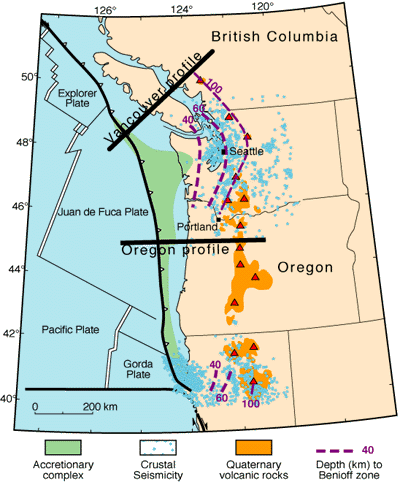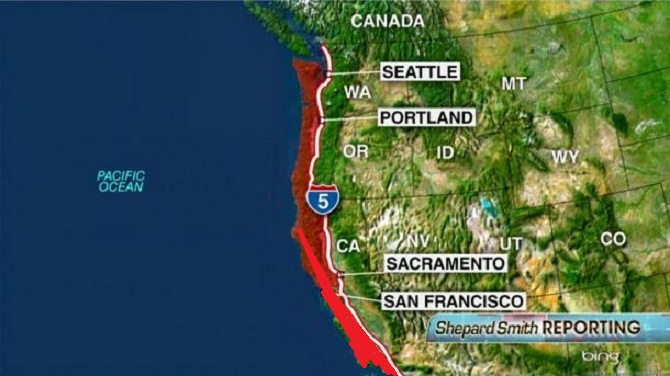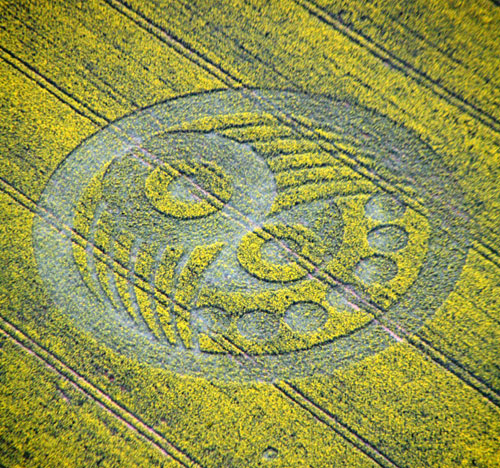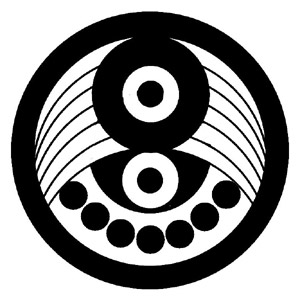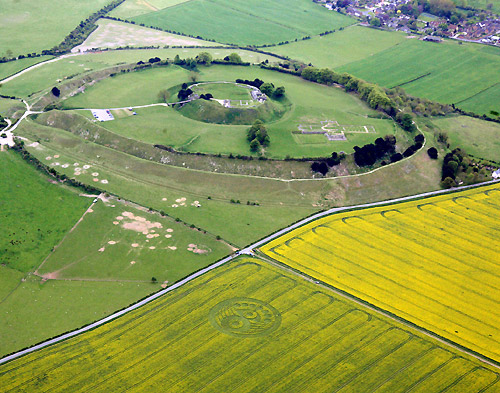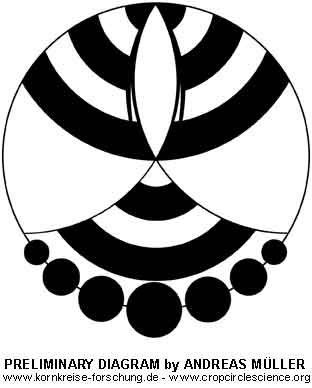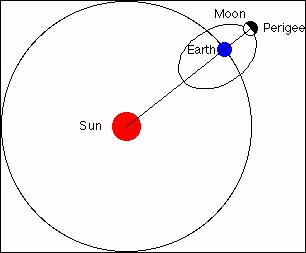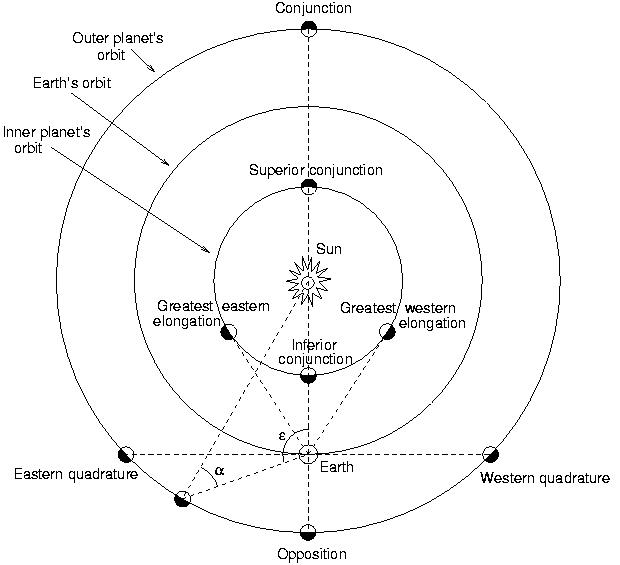April 2000
by Robert Novella
Now that we’re well into the year 2000 and Y2K fears have subsided, I thought I could relax and forget about impending global disasters. Not so, if an increasingly vocal crop of doomsayers are correct. Apparently, a planetary alignment that will occur on May fifth will wreak havoc on the Earth that will make crashing computers seem like a harmless virus. We are told to expect solar flares, force 13 earthquakes, 500 mph winds and tidal waves flooding our coastal cities. Massive planets lining up on one side of the sun may seem like an inauspicious event with dire consequences, but the astronomical facts that scientists deal with every day reveal it to be a relatively common and inconsequential event.
On May 5th 2000 the Sun and inner 6 planets of our solar system will (or did, depending when you read this) align starting with the Earth on one end, followed by the Sun, Mercury, Venus, Mars, Jupiter and finally Saturn. Even the moon will be roughly between the Earth and Sun. This so called “Grand Conjunction” has many people extremely concerned about the potential effect this will have on our planet. The catch-phrase- “Beware 5-5-00” is even being used to echo this dread and attract newcomers to this latest apocalyptic meme.
The idea that planetary alignments can cause destruction on the Earth is not a new one. Records dating from 300 B.C. express fears similar to those found today. One would think that advances in astronomy and science would abolish such superstitious concerns but such beliefs are ubiquitous in first world nations as well as third. Predictions for the May fifth conjunction range from the astronomically uninformed to virtually incomprehensible. Here’s an example of the former from the Survival Center1 web site:
“On or around May 5, 2000 (give or take a few days) these planets … will line up on one side of Earth creating major stress on Planet Earth. Predictions range from a few earthquakes to major earth crust movement (slippage), polar ice cap movement, sea levels rising 100 – 300 feet or more, huge tidal waves, high winds 500 to 2000 mph, earthquakes so massive that Richter 13 or more could be possible, both coasts of USA under water, magnetic shift and much more.”
Most predictions about the May fifth alignment are similar to those expressed above, as such; the thrust of this article will address their feasibility. Other predictions I have encountered are so out there that I would not know where to begin when addressing them. The following is from Kirael’s Inward Portal2 web site:
“The Great Shift of May 5, 2000 marks the Day of Epiphany for the Earth plane when a great Light Shift will occur that will bring you out of darkness. It is a major shift for the Light Workers of the world when every Light Worker on Earth has the opportunity to shift their embodiment process to their Light Body. Your bodies will begin to lose their density, and you will begin to feel the body moving towards Light emergence. This Shift is the forerunner of the Golden Shift itself into the Fourth Dimension.”
Um, OK.
Alignments involving most of the planets are not exceedingly rare celestial events. They have happened many times throughout human history with no deleterious effect on Earth. A sampling taken between the years –3101 and +2735 reveal 102 separate planetary groupings of the 5 naked eye planets within 25 degrees (1994 De Meis and Meeus). This is an average of one every 57 years. When was the last time a conjunction like 5-5-00 occurred? On February 4th, 1962 when the 5 naked eye planets were separated by only 17 degrees. In conjunction with this conjunction there was also an eclipse of the sun. During this event the Griffith Observatory in Los Angeles was besieged with inquiries about the ramifications of the event. During the day of the alignment the road leading to the observatory was clogged with cars for more than half a mile. The year 1821 saw a similar grouping, also with no concomitant disasters. In fact, no correlation has ever been shown between planetary alignments and events such as earthquakes and volcanic activity. The term “alignment” itself is somewhat misleading. The planets will not form a straight line (regardless of the many “artist interpretations” I have seen). The phrase “multiple conjunction” is more accurate.
Assessing past conjunctions is illuminating but the heart of the matter is the feasibility of loosely aligned planets having an extra effect on the Earth purely due to their relative mutual positions. The most often cited culprits of this extra effect are the combined gravitational pull of the planets and the tidal forces. These are the only ways that planets can affect us, so if these forces can be implicated, then doomsday arguments would be bolstered at least into the realm of possibility.
Gravity depends on only two variables; the mass of the object and its distance. The greater the mass the stronger the attraction, the greater the distance, the less the attraction (for the purposes of this discussion I will ignore Einstein’s General Relativity interpretation of gravity as the curvature of space-time). Isaac Newton altered physics forever when he realized that the strength of gravity depends on the square of the distance. For example, if you double the distance between two objects, the gravitational force drops by a factor of 4 (2 x 2). At 100 times the distance, the force drops by 10,000 (100 x 100). Even though gravity is the force that shapes the large-scale structure of the universe, it is extraordinarily weak. The inverse square law shows that not only is it weak, but what strength it does have drops off very quickly. The result is that to have a significant gravitational effect on the Earth, an astronomical body need be relatively close or absolutely gargantuan. This, of course, applies only to two bodies in our solar system, the moon and sun. All other heavenly bodies have a completely negligible gravitational impact on the Earth. Even titanic Jupiter, so large that 1000 earths can easily fit inside, is so far away that it has only 1 percent the pull of the moon. If you add all the other planets together, the amount is a paltry 2 percent. But wait, it gets weaker. During the conjunction of May 5th the Earth is on one side of the Sun and Mars, Jupiter, Venus and Saturn are on the other. This greater distance attenuates gravity to its absolute minimum.
The second most frequently cited effect of planetary conjunctions is a relative of gravity but has unique characteristics of its own. So called tidal forces are not strictly gravitational but involve the difference in gravity between two separate points. This differential force is more of a stretching than a pulling and as such has a greater potential for damage than simply pulling an object. Gravity has the potential of pulling the Earth from its orbit, tidal forces, on the other hand, can conceivably rip it in two. Earth’s tides are caused by the moon’s tidal forces. One way to look at it is that the ocean nearest the moon is pulled away from the Earth because it is attracted most strongly. The far side of the Earth is pulled least strongly so, in essence, the earth underneath is pulled away from it. Tidal effects are not limited to malleable water only, however. A slight but measurable bulge in the land itself propagates through the crust.
Fortunately, the same reasons that gravity failed to account for conjunction disruptions also account for the failure of tidal forces, only more so. Whereas gravity decreased by the square of the distance, tidal forces decrease by the cube. Twice the distance from a planet, therefore, lessens the force by a factor of eight. Consequently, distance is more crucial than mass when it comes to tidal forces. The sun’s gravitational pull on the Earth is 180 times that of the moon, however, the moon has twice the tidal effect on Earth because it is so much closer. The best way to look at this is to compare the ratio of the Earth’s diameter to the distance to the sun and moon. Since the ratio is much higher for the moon, the differential gravitational force will be a greater percentage of the total gravitational force.
The tidal effect on the earth from the other planets is therefore completely inconsequential regardless of their alignment. The planet Venus stretches us the most because it is closer to us, on average, than the other planets. The force, however, is 5 hundred thousandths that of the moon. The remaining planets contribute even less. This past December when the moon was full and unusually close, the additional tidal stresses on the earth were one thousand times stronger than all the planets combined. I don’t remember any doomsday predictions back then.
Doomsday planetary conjunctions seem superficially reasonable. People undoubtedly assume that when the planets line up the gravitational effects are magnified, conceivably causing earthquakes and volcanic eruptions. After all, this magnification of forces is like the spring tides during which the earth, moon, and sun line up to produce the highest tides twice per month. This bimonthly alignment, however, involves the only planetary bodies in the solar system that can affect the Earth given their size and distance. All the other planets are simply too far away. Any effect they might have is completely swamped by the sun and moon. Planetary alignments are common astronomical events and they can be beautiful, as in the case of eclipses, but one thing they have never been nor will they ever be is deadly.
References
1) Survival Center1 web site
http://survivalcenter.com/echange.html
2) Kirael’s Inward Portal2 web site
(http://www.inward.com/may5.html)
3) “Quintuple planetary groupings — Rarity, historical events
and popular beliefs,” Salvo De Meis & Jean Meeus, Journal of the
British Astronomical Association, 104, #6, pp. 293-297, December
1994.
FROM: http://www.theness.com/conjunction-assumption/
See: http://www.irf.se/~yamau/conference/20100218-Uppsala-yama.pdf
2010 Sky Events...- Jan 03 - Earth at perihelion
Jan 03 - Quadrantid meteor shower peaks
Jan 05 - Saturn near the Moon
Jan 10 - Mercury begins a dawn apparition
Jan 11 - Venus in superior conjunction
Jan 15 - Annular eclipse of the Sun for Africa, India and China
Jan 27 - Mercury at maximum elongation in the dawn
Jan 29 - Mars at opposition
Feb 11 - Mercury near a Thin Moon
Feb 16 - Jupiter near Venus
Feb 20 - Vesta at opposition
Mar 01 - Venus begins an evening apparition
Mar 03 - Venus near Uranus
Mar 10 - Jupiter emerges into the morning sky
Mar 16 - Venus near a thin Moon
Mar 20 - Spring Equinox
Mar 20 - Mercury begins an evening apparition
Mar 22 - Saturn at opposition
Mar 29 - Saturn near the Moon
Apr 02 - Mercury near Venus
- Apr 08 - Mercury at maximum elongation
Apr 15 - Conjunction of Mercury, Venus and the Moon
Apr 16 - Lyrid meteor shower peaks
Apr 16 - Moon near the Pleiades
May 01 - Mercury begins a dawn apparition
May 06 - η-Aquariid meteor shower peaks
May 09 - Jupiter near the Moon
May 15 - Venus near the Moon
May 26 - Mercury at maximum elongation in the dawn
Jun 01 - Jupiter near Uranus
Jun 14 - Venus near the Moon
Jun 18 - Saturn near the Moon
Jun 19 - Ceres at Opposition
Jun 21 - Summer Solstice
Jun 25 - Partial lunar eclipse, favoring the Pacific Ocean
Jul 01 - A series of evening planetary conjunctions begins and lasts for the next two months
Jul 02 - Jupiter near the Moon
Jul 04 - Mercury begins an evening apparition
Jul 06 - Earth at aphelion
Jul 11 - Total solar eclipse for the South Pacific
Jul 12 - Mercury near the Moon
Jul 13 - Line of four bright planets in the evening sky
Jul 14 - Venus near the Moon
Jul 15 - Mars near the Moon
Jul 27 - Mars near Saturn
Jul 30 - Jupiter near the Moon
- Aug 05-15 - Conjunction of Mercury, Venus, Mars and
Saturn within 20° in the sunset
Aug 07 - Mercury at maximum elongation in the sunset
Aug 11-14 - The Moon joins the conjunction of Mercury, Venus, Mars and Saturn in the sunset
Aug 12 - Perseid meteor shower peaks
Aug 13 - Venus and Saturn near Mars
Aug 16 - Venus near Mars
Aug 20 - Venus at maximum elongation
Aug 26 - Jupiter near the Moon - Aug 27-28 - Venus/Mars conjunct in Libra
- Congruent with Aug 27-28th timeframe, Saturn in Libra
is exactly square Pluto in Capricorn @2 degrees 56 seconds.
I guess Moon in Aries (also conjuncting Jupiter and
Uranus)) opposing Saturn and squaring Pluto forms that T
Square, and it is quite a 'busy' one. Maybe somebody can do
chart for LA/California?
Sep 06 - Mercury begins a dawn apparition
Sep 10 - Venus and Mars near the Moon
Sep 13 - Saturn leaves the evening sky
Sep 17 - Jupiter near Uranus
Sep 19 - Mercury at maximum elongation in the dawn
Sep 21 - Jupiter at opposition
Sep 22 - Jupiter near the Moon
Oct 09 - Venus and Mars near the Moon
Oct 15 - Saturn returns to the dawn sky
Oct 19 - Jupiter near the Moon
Oct 21 - Orionid meteor shower peaks
Oct 29 - Venus at inferior conjunction
Nov 01 - Venus begins a dawn apparition
Nov 02 - Mercury begins an evening apparition
- Nov 15 - Jupiter near the Moon
Nov 17 - Leonid meteor shower
Nov 19 - Conjunction of Mars and Mercury
Dec 01 - Saturn near the Moon
Dec 01 - Mercury at maximum elongation in the sunset
Dec 02 - Venus near the Moon
Dec 06 - Conjunction of Mercury, Mars and the Moon
Dec 12 - Jupiter near the Moon
Dec 13 - Geminid meteor shower peaks
Dec 21 - Total lunar eclipse, favoring North American and the Pacific
Dec 21 - Winter Solstice
Dec 28 - Saturn near the Moon
Dec 30 - Jupiter near Uranus
Dec 31 - Venus near the Moon -
Note- Unless otherwise noted times and positions are shown for the island of Hawai'i using Hawaiian Standard Time, 20°N latitude, 155°W longitude, for other locations most events listed will also be visible, but times and positions will vary, check a local reference or use a planetarium program to verify event details for your location
